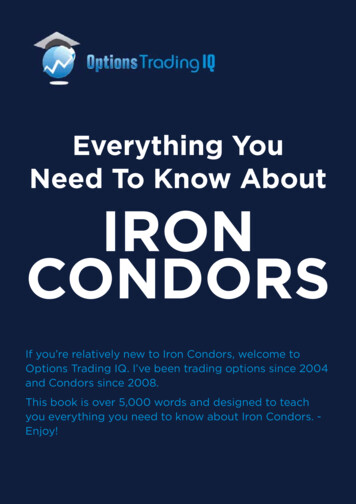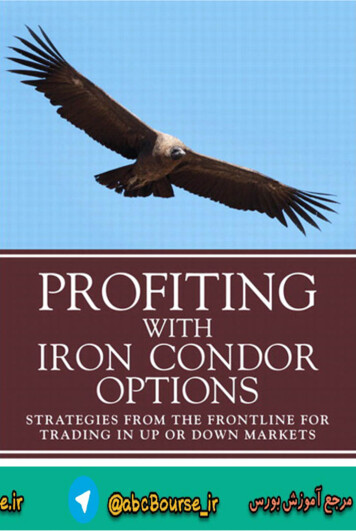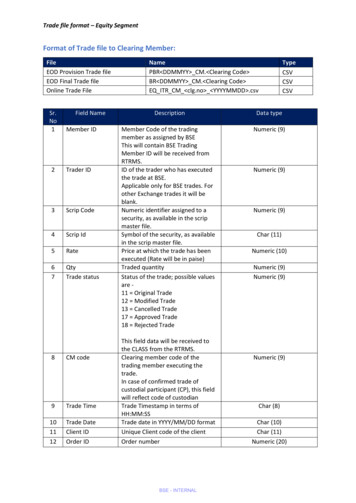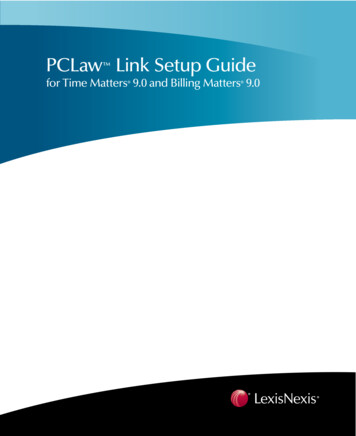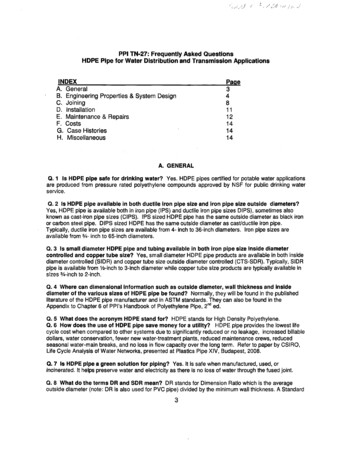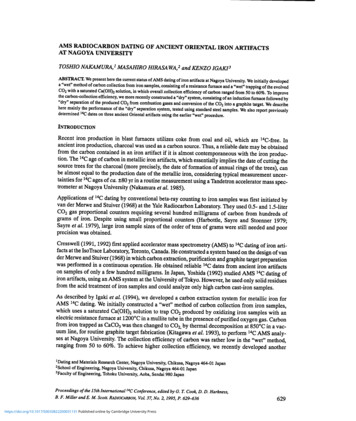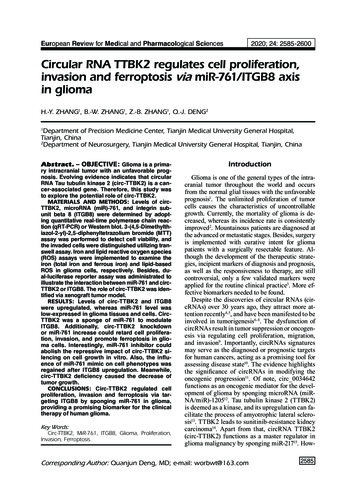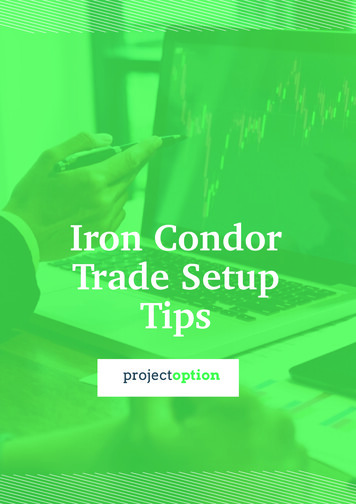
Transcription
Iron CondorTrade SetupTips
Iron Condor Trade Setup TipsAfter determining which stock you'd like to sell an iron condor in, you'll have tomake a few decisions when setting up that trade:1) Which expiration cycle to use (how much time to expiration?)2) Which strike prices to use (which calls/puts will I sell and which calls/putswill I buy?)In this quick guide, I'll share with you some common trade setup approaches so thatyou can feel more confident when setting up iron condor trades of your own.Iron Condor Trade Setup Tipspage.01
Choosing an Expiration CycleThe easy part about most options-selling strategies is that traders often use timeframes between 30-60 days to expiration.That's because options experience lots of time decay (the loss of extrinsic value thatoccurs in all options as time passes) in the final weeks/months before they expire.By selling options between 30-60 days to expiration, we can sell options that are bothfar enough away from the stock price to allow a decent range in which the stock pricecan move, but we also collect adequate amounts of option premium for selling thoseoptions.When selling options with very little time to expiration, say 7 days, we'll have to selloptions with strike prices very close to the stock price to collect any decent optionpremium, which means we'll leave the stock with a narrow range in which it can movebefore the position becomes unprofitable.Tip #1: When selling iron condors, it's very common to use expirations with 30-60days until expiration. Use this as a rough guideline and don't be afraid to branchoutside of this range.For example, a 28-day or 65-day expiration cycle would be just fine, but roughly 30-60days is the target.On the tastyworks trading platform, here are two expiration cycles in AAPL that fit theguideline:Iron Condor Trade Setup Tipspage.02
Selecting Strike PricesUsing the 67-day expiration cycle from the previous AAPL image, let's look at acommon way of selecting strike prices for a short iron condor trade.Step #1: Select the short strikes, or the strike prices of the calls and puts that will besold.Step #2: Select long strikes (options that will be purchased) that are a certaindistance from the short strikes. For instance, if I wanted 5-wide spreads in my ironcondor position, the options I'd purchase would have strike prices 5 below thechosen short strikes.For this example, I'll be using the option deltas to select my short strike prices.While the delta of an option tells us how much the option price is estimated to changewith a 1 change in the stock price, delta is often an estimator of the option'sprobability of expiring in-the-money.If I sell an option with a delta around 0.16, that option has an estimated 16%probability of expiring in-the-money, and therefore an 84% probability of expiringout-of-the-money. In the case of selling an iron condor, we want all of the options toexpire out-of-the-money.The 0.16 delta starting point is common for iron condors because selling calls and putsat the 0.16 delta level results in a “one standard deviation” iron condor. That meansthat the iron condor has an approximate 68% probability of expiring worthless.In statistics, “one standard deviation” encompasses about 68% of the outcomesaround the mean/average. In the context of the stock market, the “mean/average” isthe stock price at the time of entering a trade.Here are the strike prices I might choose for an AAPL iron condor if I selected the 0.16delta call and -0.16 delta put, and purchased options that were 5 further than thoseshort strikes:Iron Condor Trade Setup Tipspage.03
With AAPL at 186.89, the 0.16-delta call option in the 67-day expiration cycle is the210 call. The -0.16 delta put option is the 165 put.Therefore, my short strikes are 165 and 210. To sell a 5-wide iron condor (an ironcondor with 5-wide spreads on each side), I'd purchase the 160 put and 215 call(shown above).The result? An iron condor with 118 in profit potential and 382 in loss potential, butan estimated 75% probability of making money at expiration in 67 days.The same approach can be used even with different delta values and spread widths.For instance, a trader might want to collect more premium for an iron condor, in whichcase they might sell the 0.25 delta call and -0.25 delta put (which will be closer to thestock price) and purchase options 10 further than those strike prices.The result of that approach would be an iron condor with a narrower range of maximumprofitability, a lower implied probability of making money, but more profit potentialand more risk due to having wider spreads on both sides.Iron Condor Trade Setup Tipspage.04
Questions?If you have any specific questions regarding any of this, please send me an email atChris@projectoption.com.I'm always happy to help!Get a Free Options Trading Course ( 247 - 497 Value)Open and fund your first account with tastyworks using the PROJECTOPTIONreferral code and we'll give you full, lifetime access to one of our paid optionstrading courses for free.Click Here to Learn More.DisclaimerNeither projectoption or any of its officers, directors, employees, other personnel, representatives,agents or independent contractors is, in such capacities, a licensed financial adviser, registeredinvestment adviser, registered broker-dealer or FINRA SIPC NFA-member firm. projectoption does notprovide investment or financial advice or make investment recommendations. projectoption is not inthe business of transacting trades, nor does projectoption agree to direct your brokerage accounts orgive trading advice tailored to your particular situation. Nothing contained in our content constitutes asolicitation, recommendation, promotion, or endorsement of any particular security, other investmentproduct, transaction or investment. Trading Futures, Options on Futures, and retail off-exchange foreigncurrency transactions involves substantial risk of loss and is not suitable for all investors. You shouldcarefully consider whether trading is suitable for you in light of your circumstances, knowledge, andfinancial resources. You may lose all or more of your initial investment. Opinions, market data, andrecommendations are subject to change at any time. All information presented for educationalpurposes only. Past Performance is not necessarily indicative of future results.tastyworks, Inc. (“tastyworks”) has entered into a Marketing Agreement with projectoption (“MarketingAgent”) whereby tastyworks pays compensation to projectoption to recommend tastyworks' brokerageservices. The existence of this Marketing Agreement should not be deemed as an endorsement orrecommendation of projectoption by tastyworks and/or any of its affiliated companies. Neithertastyworks nor any of its affiliated companies are responsible for the privacy practices of projectoptionor this website. tastyworks does not warrant the accuracy or content of the products or services offeredby projectoption or this website. projectoption is independent and is not an affiliate of tastyworks.Iron Condor Trade Setup Tipspage.07
In the case of selling an iron condor, we want all of the options to expire out-of-the-money. The 0.16 delta starting point is common for iron condors because selling calls and puts at the 0.16 delta level results in a "one standard deviation" iron condor. That means that the iron condor has an approximate 68% probability of expiring .

